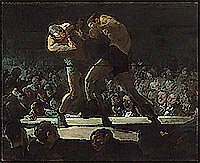Boxing has been cultivated in the Western World for about 4,000 years. This has not been a single, lineal, monolithic pursuit stemming from the same source, but an expression of an impulse to develop and maintain brutal, confrontational, masculine rituals. Boxing has been embraced by military men and civilians, by the upper class and the working class, by atheists and theists, the free and the un-free, by all races, and by both sexes.
Nature of Boxing
Boxing is not, as are most unarmed martial arts, a combative skill set pursued in order to gain combat mastery over none martial artists or practitioners of rival martial arts in survival situations. Rather, boxing is an experiential pursuit of symmetrical, ritual combat, that is a cultivation, expression and expansion of the human will. Although boxing is a biomechanical art form, which symmetrical nature renders its expression at once outwardly simplistic and inwardly nuanced, its essence is the development and cultivation of the human character in a confrontational situation, and has, for this reason, served military hierarchies and masculine fraternities for ages, as a tool for honing their human material.
Goals of Boxing
Primary: Imposition of will.
The goal of the boxer is to impose his will on a trained, conditioned, and skilled opponent.
Secondary: Intelligent Defense.
The secondary goal is to intelligently defend against his opponent’s attempts to impose his will and compromise his ability to act.
Tertiary: Render the opponent ineffective.
The offensive goal of the boxer is to compromise the opponent’s ability to impose his will.
Means of Boxing
The boxer’s goals are achieved by defeating [through impact, deception or attrition] certain systems of the human organism.
Primary: Nervous System.
Just as the objective of any right thinking general is the defeat of the enemy’s command and control centers, so is the boxer’s primary goal to prevent the enemy fighter’s brain from issuing commands to his body. The primary target of the boxer is the brain and the nervous linkage travelling through the neck to the body below.
Secondary: Cardiovascular System
Just as a general desires to prevent an enemy army from moving before going about the business of killing it or accepting its surrender, the boxer seeks to compromise the opponent’s ability to breathe and convert stored energy into motion.
Tertiary: Visual System
The deception, compromise and destruction of the opponent’s vision is the nastiest and least discussed aspect of boxing, and was the cornerstone of the bare-knuckle game [both modern and ancient]. From using the visual field of the boxer’s body to obscure his hand motions, to throwing the “blind” jab at the opponent’s eyes, to filling the eye-socket with blood, sweat and Vaseline, to knocking him unconscious, the boxer paired against his equal must somehow defeat his opponent’s vision.
Note: that the job of the referee is keyed on vision concerns and that the job of one of the three men in the corner is almost exclusively concerned with the fighter’s vision, as is the ringside physician.
Other Goals and Means
Other combat arts specialize in rending joints, tearing muscles, positioning the body, breaking bones and inflicting pain.
Pain, in particular, is not a concern of the boxer, as his art is a symmetrical contest against other boxers, whose first lesson is the conquest of pain. The masculine will exists in that realm beyond the conquest of pain. Thus the pursuit of an art that seeks to inflict pain is—by leaving the contest in the mind of the opponent for him to settle according to the quality of his character—is beneath consideration.
A good example of the boxing approach is the body punch to the rib cage.
The boxer does not seek to break a rib trusting to the resulting pain to discourage his rival, but to compromise the operation of the entire cage by stressing the soft tissues that move the ribs, permitting the lungs to expand and fuel the body.
We attack “the wind” as the old boxing term goes, not the bone.
Tools
The boxer’s tools comprise the entire body, with the hands designated as the primary point of contact. The boxer who permits himself to focus on boxing as a hand art—or worse a punching skill set—rather than a whole-body art, is going to suffer accordingly.
If you are interested in the origins and mechanics of boxing, checkout The First Boxers, via the link below:











